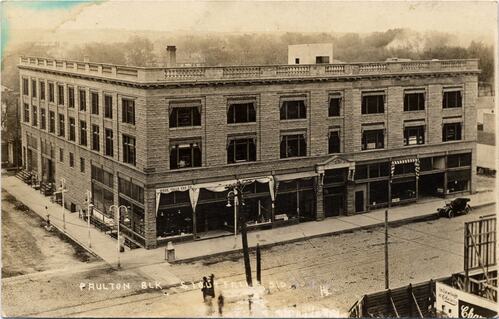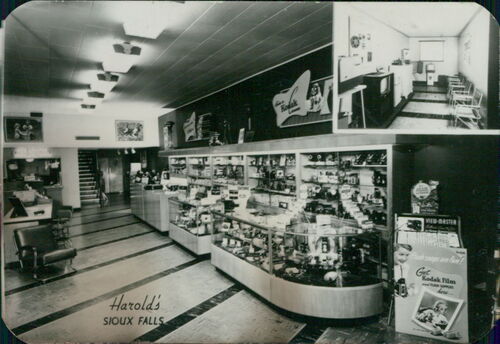Harold's Photography
308 S. Phillips
912 W. 41st
117 W. 9th
Empire Plaza
2711 S. Louise and several non-Sioux Falls locations.
912 W. 41st
117 W. 9th
Empire Plaza
2711 S. Louise and several non-Sioux Falls locations.

The first Harold’s Photo opened on Saturday, May 6, 1939 in the Paulton Block at the southeast corner of 11th and Phillips. The business was named for Harold Hanson, who managed the business co-owned by his brother Howard, who was in charge of the sales department. Amateur photography was very popular at the time and Harold’s was a great place for all photo needs. Moving and still cameras and film could be purchased, as well as the supplies needed to develop the film. If your photography skills stopped at the camera, Harold’s could also process your film in as little as seven hours.
The sales floor was designed by Dick Nohlgren, who chose a two-tone gray color scheme with touches of maroon and chrome trim. Staff would wear uniform gray jackets to match these design elements. Nohlgren used indirect lighting on display cases, hiding the lights above the cases. Large, cut-out letters indicated the main sales areas for cameras, developing, framing, accessories and other areas. In the back was a photo studio where customers could get engagement or other portraits taken.
In the basement was a climate-controlled film processing area laid out in a straight line of dark rooms for each step in the film and photo processing journey. The first room contained tanks filled with the processing chemicals through which film was carried to be processed and bring the images forth. The tanks were all carefully temperature controlled, a very important detail in quality processing. In the next room, the film would be dried by slowly-circulating fans. This was a dust-free environment. Next up was the enlarging room, where the images on the negatives were projected onto special photographic paper. This paper, once exposed, would have to have its own processing to fix the image onto it. Much of this process was automated, and the printers could process 500 pictures per hour. The whole operation could process 750 rolls every seven hours. Harold’s partnered with many local retailers so that customers could drop off their film at several convenient locations and pick up their prints at the main store.
The sales floor was designed by Dick Nohlgren, who chose a two-tone gray color scheme with touches of maroon and chrome trim. Staff would wear uniform gray jackets to match these design elements. Nohlgren used indirect lighting on display cases, hiding the lights above the cases. Large, cut-out letters indicated the main sales areas for cameras, developing, framing, accessories and other areas. In the back was a photo studio where customers could get engagement or other portraits taken.
In the basement was a climate-controlled film processing area laid out in a straight line of dark rooms for each step in the film and photo processing journey. The first room contained tanks filled with the processing chemicals through which film was carried to be processed and bring the images forth. The tanks were all carefully temperature controlled, a very important detail in quality processing. In the next room, the film would be dried by slowly-circulating fans. This was a dust-free environment. Next up was the enlarging room, where the images on the negatives were projected onto special photographic paper. This paper, once exposed, would have to have its own processing to fix the image onto it. Much of this process was automated, and the printers could process 500 pictures per hour. The whole operation could process 750 rolls every seven hours. Harold’s partnered with many local retailers so that customers could drop off their film at several convenient locations and pick up their prints at the main store.

Over the years, film processing became more and more efficient, and 7-hour processing gave way to 4-hour processing, which gave way to 1-hour processing. Harold’s rolled with the changes in the industry, keeping up with technical advancements all the way up to digital.
In 1975, Harold’s opened a new location in The Empire Plaza Mall. This exciting new location would sell cameras, film, and other accessories, and develop photos until it moved to a larger location at 2711 S. Louise in 2003.
In 1977, Harold Hanson purchased the Paulton block, in which the main store was located, but retired a short time later. His sons, Rick and Tom, and Howard’s son Bob bought the business. In 1985, the three made renovations to the Paulton Block, calling it Opera House Corner. The name was based a late 1800s plan to build a grand opera house at the same site, the construction of which never progressed beyond a basement. With craftsmanship and attention to detail, the building was brought back to an earlier state, which included using 1920s era lamps and fixtures found in the basement. One detail in particular was the old school elevator, which was manually operated. Rather than update the elevator to a modern control panel with buttons, the Hansons decided to employ elevator operators to give the building an extra touch of class. It was likely the last manually-operated elevator in the state.
On May 25, 1991, a fire started near the back of the Paulton block and quickly spread throughout the building. Before long it became clear to fire fighters that the fire would have to run its course, and their efforts would best be spent keeping the State Theatre to the south of it from catching fire. The State building escaped with some minor smoke and water damage, but the Hanson’s building could not be saved. They planned a new building at the corner, but these plans fell through. The void at that corner was called the Hanson hole as work on a new building continued to be delayed. In winter of 1992, the hole was filled with water and an ice skating rink was made. Skates could be rented, concessions purchased and music skated to. It really is an amazing thing to remember, but I keep thinking it can’t have happened. In January of 1994, Don Dunham took possession of the property and built Phillips Centre. While it didn’t have the same classic Wallace Dow design as the Paulton block, it was at least not a hole.
In 1975, Harold’s opened a new location in The Empire Plaza Mall. This exciting new location would sell cameras, film, and other accessories, and develop photos until it moved to a larger location at 2711 S. Louise in 2003.
In 1977, Harold Hanson purchased the Paulton block, in which the main store was located, but retired a short time later. His sons, Rick and Tom, and Howard’s son Bob bought the business. In 1985, the three made renovations to the Paulton Block, calling it Opera House Corner. The name was based a late 1800s plan to build a grand opera house at the same site, the construction of which never progressed beyond a basement. With craftsmanship and attention to detail, the building was brought back to an earlier state, which included using 1920s era lamps and fixtures found in the basement. One detail in particular was the old school elevator, which was manually operated. Rather than update the elevator to a modern control panel with buttons, the Hansons decided to employ elevator operators to give the building an extra touch of class. It was likely the last manually-operated elevator in the state.
On May 25, 1991, a fire started near the back of the Paulton block and quickly spread throughout the building. Before long it became clear to fire fighters that the fire would have to run its course, and their efforts would best be spent keeping the State Theatre to the south of it from catching fire. The State building escaped with some minor smoke and water damage, but the Hanson’s building could not be saved. They planned a new building at the corner, but these plans fell through. The void at that corner was called the Hanson hole as work on a new building continued to be delayed. In winter of 1992, the hole was filled with water and an ice skating rink was made. Skates could be rented, concessions purchased and music skated to. It really is an amazing thing to remember, but I keep thinking it can’t have happened. In January of 1994, Don Dunham took possession of the property and built Phillips Centre. While it didn’t have the same classic Wallace Dow design as the Paulton block, it was at least not a hole.
© www.GreetingsFromSiouxFalls.com
